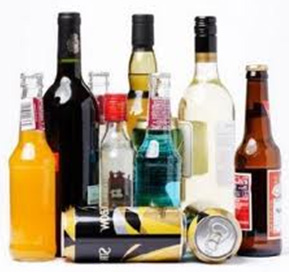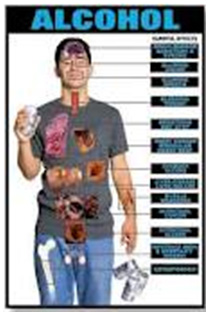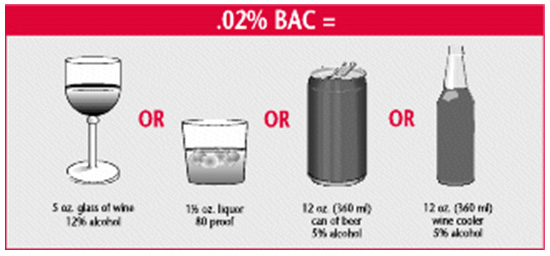All alcoholic beverages are drugs,a depressant that attacks the central nervous system and a poison which will take up to 24 hours to remove from the body from the time drinking has stopped.
 Alcohol is absorbed unchanged into the stomach and into the small intestines. It is promptly disseminated by
Alcohol is absorbed unchanged into the stomach and into the small intestines. It is promptly disseminated by  the bloodstream to all parts of the body, including the brain.
the bloodstream to all parts of the body, including the brain.
The depressant effects of alcohol on the nervous system are proportional to the amount of alcohol in the blood.
- This is related to the quantity consumed, the length of time since drinking began, the time between drinks, the nature of the alcoholic beverage, the body weight of the person drinking and the speed of the absorption.
- Absorption is delayed by the presence of food in the stomach and the concentration and nature of the alcoholic beverage.
Elimination process of alcohol from the body
About 90% to 95% of the alcohol is converted to carbon dioxide and water, a process that begins in the liver. The other 5% to 10% are excreted through the lungs and kidneys.
Note:
Exercise, fresh air, cold showers, coffee or any other so called “remedies” does not accelerate elimination of alcohol from the body system.
Understanding Alcohol Levels
- You may not realize it, but there are different amounts of alcohol in various alcoholic beverages that you can purchase and consume. For example, wine has a higher concentration of alcohol than beer. Liquor is much more concentrated than both of these drinks. Because of these discrepancies, different amounts of each liquid are served in “one drink.”
- In the United States, a single serving of alcohol is considered to have 0.6 servings of ethanol, which is the drug that causes one
 to become inebriated. Typically, this amounts to 12 oz. of beer, 5 oz. of wine or 1.5 oz. of a 80-proof liquor.
to become inebriated. Typically, this amounts to 12 oz. of beer, 5 oz. of wine or 1.5 oz. of a 80-proof liquor.
- These numbers may change, however, depending on the strength of the specific wine, beer or liquor. On average, beers have about 5% alcohol content, wine has about 15% alcohol content, and liquor has 40%, but these numbers can vary. Because of this, drivers can’t always base their intoxication levels on how many drinks they have had. They must also pay attention to how they are feeling as they consume their beverages.
Stages of Alcohol Influence
An individual who continues to drink more rapidly than the alcohol is eliminated from the body generally goes through the following stages of alcoholic influence:
1) Mostly sober (hardly influenced)
2) Elation
3) Excitement
4) Confusion
5) Stupor
6) Unconsciousness
7) Death
Blood Alcohol Concentration (BAC)
- BAC refers to the amount of alcohol contained in a person’s blood.
- It is measured as weight per unit of volume. Typically this measurement is converted to a percentage such as 0.10%, which indicates that one-tenth of a percent of a person’s blood is alcohol.
- Because alcohol in the blood travels directly to the brain, cognitive functioning is affected, resulting in increased risk of many kinds of injuries.
- Most significant among these is the risk of a motor vehicle crash when a person drives with too great a concentration of alcohol in his or her system.
- Studies show that the higher the BAC, the less accurate you are in assessing your own BAC level.
| 0.02%-0.04% BAC |
|
| 0.04% BAC |
|
| 0.05% BAC |
|
| 0.07%-0.08% BAC |
|
| 0.09%-0.10% BAC |
|
| 0.12% BAC |
|
| 0.20% BAC |
|
| 0.30% BAC |
|
| 0.40% BAC |
|
| 0.50% BAC |
|
- BACs may vary widely.
- They will generally be higher for women than for men drinking the same quantities at the same rate.
- People of the same sex, drinking the same amount of alcohol can have very different BAC readings.
- Any one person drinking the same amount of alcohol can also reach different BACs on different.
Testing Blood Alcohol Level
Measurement of the concentration of alcohol in the body is usually done with a blood test, a urine test or a breath test.
Zero Tolerance
- Young drivers are at a higher risk to be involved in an alcohol-related crash. Research shows that more than 33 percent of all fatalities of 15 through 20-year-olds result from a motor vehicle crash and of these, more than 35 percent are alcohol-related.
- Impaired driving poses a significant threat for underage drivers (individuals under the age of 21) and presents a unique challenge to law enforcement agencies. In order to address these concerns about this group, zero tolerance laws have been enacted in all 50 states. Zero tolerance applies different standards to underage drivers than to the rest of the driving population. ?Zero tolerance means zero chances. Zero tolerance laws provide different policies regarding underage drivers because of their increased crash risk at low BAC levels. Penalties for violating zero tolerance laws may include license suspension and revocation, significant fines and community service. Strong enforcement of zero tolerance laws works and exists to ensure safer driving habits for young people.
How Alcohol Affects Driving and Similar Skills
- Slowed reaction time
- Even small quantities of alcohol will affect your driving ability to some degree. You may react more slowly than usual when something unexpected happens (e.g. a car approaching from a side street, traffic lights changing color, people crossing the road).
- Poor judgment
- You could have trouble judging both your speed and that of other vehicles. You may also have problems judging distances.
- Impaired vision and hearing
- After drinking alcohol, drivers tend to focus on the road straight ahead and neglect what is happening in their side vision. You may not see cars approaching from side streets or people crossing the road or may not hear the warning bells of a crossing or car horn.
- Poor coordination
- You may have trouble doing more than one thing at a time, especially in an emergency.
- False sense of confidence
- After drinking alcohol, you may feel more confident. But in fact, you will be less able to cope with unexpected events.
- You may take risks you would not normally take. Some people may show these effects after drinking only small amounts of alcohol.
- The tolerance to the sedative effects of alcohol seen in some heavy drinkers does not lessen the impairment in driving skills due to alcohol. The effects of alcohol can be especially dangerous when combined with other drugs, magnifying the effects of sleeping pills, cannabis, prescribed medicines including anti-psychotics and strong painkillers and cold remedies.
- Effects can be unpredictable when combined with stimulants such as caffeine, cold remedies, appetite suppressants and amphetamines.

